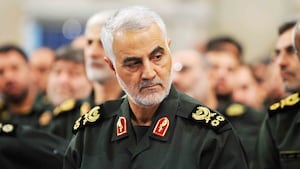TEL AVIV – The Warsaw Conference on Middle East Peace and Security last week didn’t seem to deliver much in the way of peace or security for the assorted countries attending. There was, to be sure, a lot of tough talk against Iran and the projection of a united front as Israeli Prime Minister Benjamin Netanyahu and several senior Arab officials all gathered in one room. Yet far away from the bright lights of the Trump-engineered summit, on the business end of the battle against Iran, Israeli security officials have a singular preoccupation: suitcases.
In interviews with The Daily Beast, senior Israeli military officers outlined new details about Iran’s plans to turn a vast arsenal of relatively dumb rockets in Syria and Lebanon into a deadly array of precision-guided missiles. The key, according to Israel, is a Global Positioning System (GPS) “kit” the size of small roll-aboard luggage.
The Israel-Iran shadow war in (and above) Syria and the surrounding countries has evolved over the last two years. By early 2017, and despite the ongoing civil war, the survival of Syrian President Bashar al-Assad’s regime was relatively assured due to the intervention of Russia, Iran, Lebanese Hezbollah and various other Iranian-backed militias. With its ally looking more secure, Iran embarked on a grandiose plan for increasing its influence in the shattered country.
As Lt. Gen. Gadi Eisenkot, the recently retired Israel Defense Forces (IDF) chief of staff, told The New York Times last month, “Their vision was to… build a force of up to 100,000 Shiite fighters from Pakistan, Afghanistan, and Iraq. They built intelligence bases and an air force base within each Syrian air base. And they brought civilians in order to indoctrinate them.” Eventually Iran tried to introduce anti-aircraft systems, rockets and missiles, and a drone program.
Iranian attempts to transfer advanced weapons to Hezbollah via Syria were ongoing and also deemed a “red-line” by Israel.
By mid-2017, Eisenkot said, the IDF was striking inside Syria several times a week to stem what Israeli officials term Iran’s “entrenchment” across its northern border. Hundreds of air raids reportedly took place; Eisenkot said 2,000 bombs were dropped in 2018 alone.
The impact was decisive. The Iranians “are still there,” Netanyahu told VOA Persian last week, “but they would have been in a much greater presence if we hadn’t done it. And in fact, the presence has shrunken somewhat.”
Beginning last year, Iranian forces in Syria started retaliating directly against Israel: an armed drone incursion in February led to Israeli air strikes against the aforementioned drone program; there was a rocket barrage in May; and this past January a guided missile attack targeted an Israeli ski resort on the Golan Heights. The missile, thought to be the first of its kind fired at Israel from Syria, was intercepted by the Iron Dome system.
Still, Israel was winning the shadow war—a point Israeli political and military leaders haven’t shied away from trumpeting in recent weeks. In weirdly personal terms, they often speak directly of the shadowy architect of the Iranian effort: Qasem Soleimani, head of the elite Quds Force in the Islamic Revolutionary Guard Corps (IRGC).
“His error was choosing a playground where he is relatively weak,” Eisenkot told the Times, referring to Soleimani. “We have complete intelligence superiority in this area. We enjoy complete aerial superiority. We have strong deterrence and we have the justification to act.”
Given that many weapons systems, and men, were constantly going up in smoke, Iran was compelled to shift gears. Gone were the containers of war materiel—including precision missiles—being moved into Syria. At a certain point, too, deconstructed missile parts were also deemed to be too big to transfer.
“What do you think we’re hitting in Syria?” one senior Israeli military officer asks rhetorically. “For a long time now they haven’t been moving heavy weapons.”
So, OK, what has Israel been hitting in Syria?
For the most part, it seems, small suitcase-sized GPS components that, with the right technical ability, can be installed into any (dumb) unguided rocket, turning it into a (smart) precision-guided missile capable of landing within meters of a target.
There’s much to recommend this approach from Iran’s point of view. Bigger weapons systems are easier to track and destroy; the suitcases, on the other hand, can be transferred discreetly from Iran on the ground (via Iraq) or through the air into either Syria or Lebanon.
Indeed, last October Fox News reported that these GPS components were sometimes flown directly into Beirut on Iranian civilian airliners. (The report, one of the few in the last two years on the GPS issue, may have been leaked by Israeli intelligence in order to shine a spotlight on the practice.)
The sole variable in this approach is simply the number of rockets and GPS kits available. There are known rocket stockpiles remaining in Syria—and, clearly, there are larger missiles, as last month’s launch showed—but the world leader in the field is Hezbollah in Lebanon, with an estimated 100,000 to 150,000 rockets of all ranges and payloads aimed at Israel. The added advantage of Lebanon is that Israel does not bomb there, unlike in Syria, precisely because of this massive deterrent arsenal.
As officials here in Israel never tire of pointing out, the country is small and narrow. Strikes on a handful of strategic targets—Ben Gurion International Airport, the Dimona nuclear reactor, a few power stations and air bases—could be conclusive. A recent Hezbollah propaganda video replete with satellite imagery and coordinates had these and other sites clearly visible. Making the projectiles more accurate increases the threat level and, in turn, Israel’s appreciation of the risk.
“They can put a missile on the building we’re sitting in now,” the senior officer, speaking at a base in central Israel, told The Daily Beast. “There’s an unlimited ability to put a GPS on these rockets, it only depends on how many kits they have.”
In truth, having both the kits and rockets handy is important, but so is the technical ability and the location to conduct the upgrades. The technical prowess is known to exist thanks to Iranian advances in research and development, and the wide-ranging IRGC military network that transfers the knowledge (and components) into Lebanon, Syria, Iraq, and Yemen is well established.
According to a recent detailed report on the subject by the British Israel Communication and Research Centre (BICOM), the focus—at least in Lebanon—is to upgrade Hezbollah’s existing stockpile of 14,000 long-range Zelzal-2 rockets.
The locations are a different story. Netanyahu used the occasion of last year’s U.N. General Assembly in New York to reveal publicly three underground sites near Beirut International Airport he alleged were used to convert rockets into guided missiles.
Some press reports termed the sites missile “factories,” but this was a misnomer, the senior officer said. “They’re not huge hangars like people imagine, it could be a room as small as this,” he said with a wave of his hand.
After the naming and shaming by Netanyahu, Hezbollah did in fact shut the facilities, IDF sources confirmed. Yet it is, as the senior officer added, “always a cat and mouse game with them—they do a good job of covering their tracks. They can open in another place tomorrow.”
Once the GPS components and rocket are in place, it would allegedly take a trained team just two to three hours in such a facility to convert the Zelzal into a missile: removing a middle section located between the motor and warhead, and replacing it with the internal navigation-guidance-control system.
“You insert the GPS coordinates [of the target] and it’s fire and forget,” the senior officer said—there’s no command and control back end. “It’s just like [the navigation app] Waze.”
Israeli officials are adamant that Hezbollah only possesses a small handful of precision missiles at present—a claim Hezbollah Secretary-General Hassan Nasrallah, for his part, disputes. If the Israeli version is to believed, the IDF’s free-fire efforts in Syria have paid off. The concern in certain quarters is that for this reason Iran will move in greater force into the seemingly immune Lebanese space, upping the missile precision program.
“If there will be an Iranian military entrenchment in Lebanon it’ll be a target for action,” Eisenkot promised last month in an interview to Israel’s Channel 1.
In the meantime, Israel has, since last fall, been increasing media attention on the threat in the hope that the international community applies enough pressure on Iran, Hezbollah, and the Lebanese government to forestall such an eventuality. That’s at least the idea, in order to avoid a massive war no one likely wants. At present it all seems to hinge on if Iran chooses to move ahead with its precision missile gambit.
“We’re running after suitcases,” the senior officer told The Daily Beast. “We can’t let it happen–and we won’t.”







